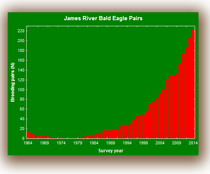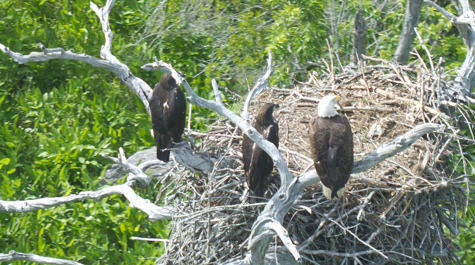James River eagle population continues its historic rise
Despite harsh weather conditions early in the breeding season, the bald eagle population along the James River continued to push forward in 2014.
The 2014 aerial survey conducted by the Center for Conservation Biology recorded 223 pairs that produced 313 young. This 8 percent population increase over 2013 matches the 30-year average. Productivity of 1.4 chicks/pair is comparable to that recorded on the river over the past eight years. Areas supporting the highest densities include Charles City County (50 pairs), James City County (35 pairs), Surry County (33 pairs) and Prince George County (26 pairs).
 During the critical months of February, March and April, 26 days of rain were recorded, totaling nearly 10 inches along the James River. The rain events included intense storms with high winds. Such poor-weather springs occur within the Chesapeake Bay every few years. In the late incubation and early chick-rearing phase of the breeding cycle, eagle pairs appear to have a difficult time coping with the relentless, cold and wet conditions. During such years, a higher than average number of pairs will fail. Depending on the timing of events, some of these pairs will recycle and lay a second clutch and others will fail for the year. Inspection of laying dates for the 2014 season shows a clear second peak. These clutches represent pairs that have failed early and recycled to produce second clutches.
During the critical months of February, March and April, 26 days of rain were recorded, totaling nearly 10 inches along the James River. The rain events included intense storms with high winds. Such poor-weather springs occur within the Chesapeake Bay every few years. In the late incubation and early chick-rearing phase of the breeding cycle, eagle pairs appear to have a difficult time coping with the relentless, cold and wet conditions. During such years, a higher than average number of pairs will fail. Depending on the timing of events, some of these pairs will recycle and lay a second clutch and others will fail for the year. Inspection of laying dates for the 2014 season shows a clear second peak. These clutches represent pairs that have failed early and recycled to produce second clutches.
Throughout the breeding range for bald eagles, the length of the breeding season declines with increasing latitude, tightening the constraints on clutch replacement. Along the northern fringe of the breeding range, the window is just long enough for young to become proficient foragers and flyers before the onset of fall migration.
This contrast in opportunities may be best seen by examining the extremes of the breeding range. Eggs may be laid in Florida over a five-month period whereas on Besnard Lake in Saskatchewan, 90 percent are reported to be laid over a ten-day period in mid-April. Time is limiting in the north and pairs do not produce replacement clutches within the extreme reaches of the range. Clutch replacement is common within the Chesapeake Bay population, but appears to have a seasonal limit. Within this mid-latitude population, we have not documented clutch replacement beyond early April.
The James River population represents the best example of bald eagle recovery in the nation. By the early 1960s, the once thriving population had been reduced to below 15 pairs due to environmental contaminants and by the mid-1970s no pairs remained along the river. Following the decline of banned compounds like DDT, recovery began with a single pair in 1980. Recovery was slow in the early years and as recently as 2000 the river supported only 57 pairs that produced 85 young. Since 2000, breeding eagles along the James have quadrupled, resulting in one of the densest populations in eastern North America.
Bryan Watts is director of the Center for Conservation Biology, a joint program of William & Mary and Virginia Commonwealth University.














